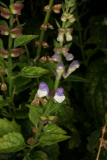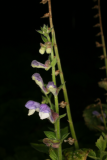Additional notes (click to expand)
Medicinal
Traditional Herbal Medicine Registration (THMR).
'Has been used in North America as a remedy for hydrophobia, but on no good grounds.'
Lindley, John. (1838). Flora Medica, Longman, Orme, Brown, Green & Longmans p.489
Medicinal uses
Uses supported by clinical data
None. Although clinical case reports suggest that Radix Scutellariae may
stimulate the immune system and induce haematopoiesis (17–19), data
from controlled clinical trials are lacking.
Uses described in pharmacopoeias and well established documents
Treatment of fever, nausea and vomiting, acute dysentery, jaundice,
coughs, carbuncles and sores, and threatened abortion (3, 4).
Uses described in traditional medicine
Treatment of allergies, arteriosclerosis, diarrhoea, dermatitis and hypertension
(7).
Contraindications
Owing to possible teratogenic and mutagenic effects (58, 59), and a lack
of safety data, use of Radix Scutellariae is contraindicated during pregnancy
and nursing and in children under the age of 12 years.
WHO Monographs on Selected Medicinal Plants. Volume 3. 2007. WHO, Geneva
Geographical distribution
- Northern America, Eastern Canada
- Northern America, North-Central U.S.A.
- Northern America, Northeastern U.S.A.
- Northern America, Northwestern U.S.A.
- Northern America, South-Central U.S.A.
- Northern America, Southeastern U.S.A.
- Northern America, Southwestern U.S.A.
- Northern America, Western Canada
Scutellaria lateriflora L.
Family: LAMIACEAEGenus: Scutellaria
Species: lateriflora L.
Common names: Blue Pimpernel; Mad Dog Weed; Mad Dog Skull Cap; Skull-Cap
Distribution summary: Northern America
Habit: Perennial
Hardiness: H4 - Hardy; average winter
Habitat: Damp meadows, sandy streamsides
Garden status: Currently grown
Garden location: North America (A)
Flowering months: June, July, August
Reason for growing: Medicinal, traditional herbal registration

